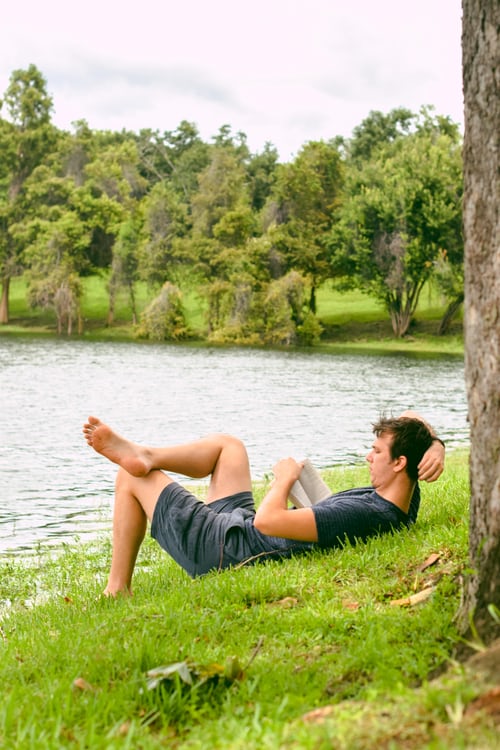I’ve been thinking a lot about sleep lately, probably because I hadn’t been getting as much sleep as I needed. Knee injury pain made sleep—or any kind of decent rest—impossible for several weeks, and my own careless lifestyle added to the problem.
I was staying up too late, reading too many articles on my phone, getting my eyeballs fried from the glaring light and lack of blinking. (You know we blink less when we stare at tech screens, don’t you? That causes our eyes to take in more light and get dry from the lack of moisturizing when benefit from when we do blink.)
I finally had enough, so I mandated some going-to-bed practices for myself and enlisted my evil cell phone for support! Next week, I’ll tell you all about what I did and how well it’s working for me. But today, I want to cover a couple of other important habits or lifestyle practices that can help you stay healthier and happy.
Like sleep, they fall into the category of rest.
Active Rest—
According to the 12 Minute Athlete, “active rest” is when you’re still moving but not at the intensity level that you normally move on a regular workout day. It’s important for people who workout daily to rest overworked muscles and aid the recovery process.
But what if you’re not an athlete, or everyday, hardcore exerciser?
Active Rest is beneficial for anyone who is busy and pretty active on a daily basis. And you don’t have to be running, lifting weights or participating in heavy cycling.
Think about your daily workload and the stress you incur while working. Do you have to run from office to office, or building to building? Are you going brain dead from all of the nonsense planning meetings you have to attend?
Active rest can be a day where you change up the pace a bit by slowing down and focusing on more relaxing, gentle movements.
According to the article, active rest can be:
- Going for an easy to moderate hike with your friends or family
- Taking an easy bike ride
- Going for an easy swim
- Light stretching
- Taking a relaxing walk (This is not power walk time!)
- Playing with your dog, kids, grandkids
- Doing some sort of fun activity that you enjoy. Maybe something new to exercise or stress different body parts. Nothing competitive.
The goal is to get moving, but not too much.
Some of the article feedback noted people doing house cleaning, Pilates and stretching. Other people liked to box. (That seems to be gaining popularity, especially among women.)
My husband used to pull out his roller blades and he, I, the kids and the dogs would head down to a local park for several zooms around the walking path. The boys would wheel right along with their dad. I was the designated dog walker, by choice. A roller blader, I’m not.
Passive Rest—
While athletes will define passive rest as participating in an active that allows your heart rate to drop back to normal as quickly as possible, we’re aiming for something a little more pedestrian or general public level here.
For our purposes, passive rest is when you’re quietly resting but still awake, and not engaged in multitasking.
I think a lot of people might engage in this too much, but there are others—like my husband—who have great difficulty just sitting and resting quietly. It’s taken years of practice, but now he looks forward to it. Advancing age may be contributing, but he’s making the most out of his passive rest periods. It’s a time he can shut his overactive brain down and recover.
What kinds of activities constitute “quietly resting?”
You could be lying on the couch with your eyes closed. My mother used to say she was “checking out the backs of her eyelids” when she did this, when we accused her of sleeping.
Although some say watching a movie or television is quiet resting, I’d be cautious about putting that in the resting category. Unless it’s a comedy or a somewhat interesting movie, television watching has been shown to actually decrease brain wave function to a damaging level. You want to rest, but I don’t think we’re aiming for brain dead.
As a society, we sit way too much and much of that sitting is down in front of a television, anyway. I would recommend that you use this rest technique judiciously and sporadically because it’s also contributed to the horrendous obesity epidemic we have going on in our country.
Another good passive rest can be a soak in a spa tub or bubble bath, eyes closed or reading a book.
But whatever you select, make sure you pick out an activity that makes you feel relaxed and that slows your breathing. Maybe coloring, brushing your dog or cat, daydreaming. Watching a sunset or sunrise. Listening to your favorite classical or acoustic worship music.
Mix it up—
Make sure you incorporate both active and passive resting periods into your week.
Sunday—the most popular day of rest—is a wonderful day to fit these in. Try using these techniques to unwind and recharge mentally, instead of using Sunday to run errands or hit the mall.
I think you’ll find the health and fitness rewards amazing!
Until next week,
Find your passive resting happy place or space.
Your brain (and body) will be celebrating!
Blessings,
Andrea
Andrea Arthur Owan is an award-winning inspirational writer, fitness pro and chaplain. She writes and works to help people live their best lives—physically, emotionally, and spiritually.
